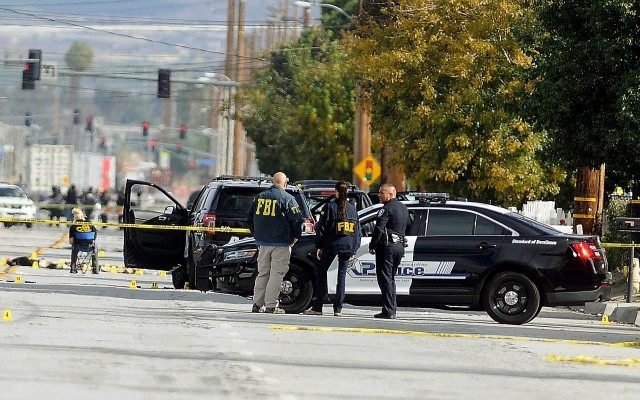CNN, which broke speed records turning the San Bernardino story into gun-control propaganda, began to grudgingly admit Thursday that there must be just a spot of terrorism involved, in a report that must be read verbatim to be properly appreciated:
Syed Rizwan Farook — who along with his wife, Tashfeen Malik, carried out the San Bernardino shooting massacre — was apparently radicalized and in touch with people being investigated by the FBI for international terrorism, law enforcement officials said Thursday.
Farook’s apparent radicalization contributed to his role in the mass shooting of 14 people Wednesday during a holiday party for the San Bernardino County health department, where Farook worked, sources said.
Still, it wasn’t necessarily the only driver behind the carnage, as workplace grievances may have also played a role. President Barack Obama hinted as much Thursday when he said that the attackers may have had “mixed motives.”
The word “apparent” seems to have been surgically stapled to “radicalization,” even as yesterday’s left-wing fantasies crumble into the fallback of “mixed motives” and “workplace grievances.” If you are wondering what sort of radicalization Farook might have undergone, tough luck, because CNN’s not interested in discussing it. How can the more “radical” version of a religious ideology that has absolutely nothing whatsoever to do with terrorism be terrorism?
They will keep trying to frame this as an extreme example of “workplace violence” for as long as possible, even though the police announced finding a dozen pipe bombs in the couple’s garage, on top of multiple dud explosives they used during their attack and getaway, and about three thousand bullets.
Farook was essentially working a part-time second job preparing to express his “workplace grievances.” How long did it take to make all those pipe bombs, including the triple explosive wired into a toy car that failed to detonate at the scene of the attack? Where did Farook and Malik learn how to make those bombs–fortunately, they don’t seem to have learned the lessons very well–and did they have any help?
(One possibility raised today that the FBI refused to comment on: they might have gotten the design from Inspire, the online magazine published by al-Qaeda.)
The more rational theory behind this talk of “workplace violence” is that Farook and Malik had a major act of terrorism planned for a different place and time, but changed their minds and struck because someone at the Christmas party said something that upset him.
Until now, we’ve been told there were no “red flags” on Farook or Malik, and this judgment is repeated in CNN’s article… right before the red flags start popping up:
Officials had previously said neither Farook and Malik were known to the FBI or on a list of potentially radicalized people. Nor had they had any known interactions with police until Wednesday.
Yet Farook himself had talked by phone and on social media with more than one person being investigated for terrorism, law enforcement officials said.
The communications were “soft connections” in that they weren’t frequent, one law enforcement official said. It had been a few months since Farook’s last back-and-forth with these people, who officials said were not considered high priority.
Actually, according to a law-enforcement source for the New York Post, Farook was in contact with “more than one international terrorism suspect whom the FBI was already investigating.”
“This was not a casual workplace argument. It’s a well-planed and thought-out attack,” another source told the Post.
Sources told NBC News Farook was “in touch with people in the Los Angeles area who have expressed jihadist-oriented views,” and he was also in “some form of communication with overseas individuals who are persons of interest to American authorities.”
Another “red flag” was the suspicious activity at Farook’s house reportedly observed by several neighbors, including the delivery of a large number of packages to the house, mysterious work being done in the garage, and a half-dozen “Middle Eastern men” hanging around the neighborhood… but they didn’t say anything, because they didn’t want to be accused of racism, according to CBS News in Los Angeles.
The dilemma facing the FBI is that they have limited human resources for surveillance, and a great deal of chatter to monitor. Distinctions between “soft connections” with suspicious individuals, and more solid connections that might warn of an impending attack, must be made. Still, these developments aren’t reassuring when trying to evaluate the federal government’s ability to screen, say, ten thousand refugees from the terrorist-haunted Syrian war zone.
It was considered a stunning revelation when FBI Director James Comey said the Bureau had over 900 active investigations of people on American soil linked to ISIS. The couple that just murdered 14 people in San Bernardino apparently were not among those persons of interest.
As recently as his Thanksgiving radio address, President Obama offered breezy assurances that “no refugee can enter our borders until they undergo the highest security checks of anyone traveling to the United States.” That would be the same overwhelmed security system that was completely blindsided by Farook and Malik. Putting even more unnecessary stress on domestic security agencies is folly.
Even if the initial screening of new arrivals goes fairly well, we just had another deadly example of how quickly “radicalization” can occur. Perhaps we’ll learn more about Farook’s history in the days to come that changes the assessment, but for right now the authorities are telling us he went from a harmless, deeply devout Muslim to a violent, heavily-armed jihadi lunatic in a matter of months. That probably isn’t a storyline the Administration and its apologists want voters pondering at length right now.

COMMENTS
Please let us know if you're having issues with commenting.